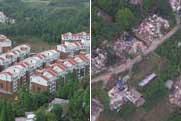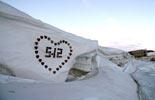China
Foreigners in Tibet: Western media reports not conform with facts
Source: Xinhua | 03-25-2008 16:37
Special Report: 3.14 Tibet RiotsLHASA, March 24 (Xinhua) -- While some Western media rashly accuse China of "violent crackdown" on the "peaceful protests" in Tibet, some foreigners there disagreed.
"Many reports were not accurate," said Tony Gleason, field director of Tibet Poverty Alleviation Fund, an American organization which helps poor Tibetans through skill training and small sum of financing.
Surfing the Internet in his hotel, Gleason saw the Western reports on the incidents in Tibet. In some reports, the riot was described as "peaceful" and "unarmed" demonstration cracked down by the Chinese government.
"The protests were by no means peaceful," Gleason said.
He recalled that he was dining at the Snowland Restaurant with his wife and one-year-old daughter on March 14 when a large group of mobsters threw bricks and hand-sized rocks at cars on the street.
"I saw black smoke from the center of the city, and there was more smoke from different parts," he said at the Gajilin Hotel where he lives and works.
"I never saw police open fire to the mobsters," he added.
Ursula Rechbach, from Slovenia, has worked more than eight years for the Lhasa-based Project for Strengthening the Tibetan Traditional Medicine.
The lady in her 50s said she was having lunch with her colleagues on March 14, when the riot started. Her Tibetan colleagues quickly accompanied her to her hotel.
"We hardly made it," Ursula said of the terrible day, adding she saw from the roof of her hotel that young people in late teens holding long sticks and stones in their hands, screaming, turning over cars, setting cars on fire, and smashing and looting shops.
She later spoke to a few other foreigners in Tibet. Based on what they had seen, they agreed that the riot must have been organized. "You can't have it all of a sudden. It can be (happening) in one place, if it is not organized. It must be premeditated, at least prepared," she said.
Commenting on some Western media accusing China of "massacring Tibetans" in their "peaceful protest", Ursula said, "You can invent some stories in order to sell better, but how can you accuse anybody if you were not there," she said.
Guzman Escardo, who works with the Association for International Solidarity in Asia (ASIA), told Xinhua that the local police had been extremely polite, contrary to what the Western media presumed.
"The police on the streets are kind and polite. They always smile at me," he said.
Escardo said he watched channel nine of China Central Television (CCTV) and the Spanish TV to see what was going on.
"The local government often contacts us to make sure I am safe. They take a lot care of me," he said. "I feel safe at the hotel."
Aside from foreigners in Tibet, tens of thousands of Chinese netizens have lashed out at a number of Western media for distorting facts in covering the riot in Lhasa.
According to the netizens, German newspaper Berlin Morningpost posted a picture on its website in which police in Lhasa rescued a young man of Han nationality assaulted by rioters. But the caption said "insurrectionist taken away by police".
In a similar case, N-TV, headquartered in Germany, was accused of using TV footage showing police with captured protestors in a report on the Tibet riot. The footage had been shot in Nepal, and the police were Nepalese.
The N-TV said on March 23 that it would check the authenticity of the TV footage, following Germany's RTL television which on the same day said that it "regretted an error" in covering the riot in Lhasa.
The RTL TV admitted that it had reported the riots with a picture taken on March 17 in the capital city of Kathmandu, where Nepalese security forces were confronting demonstrators with batons.
Editor:Zhang Ning



